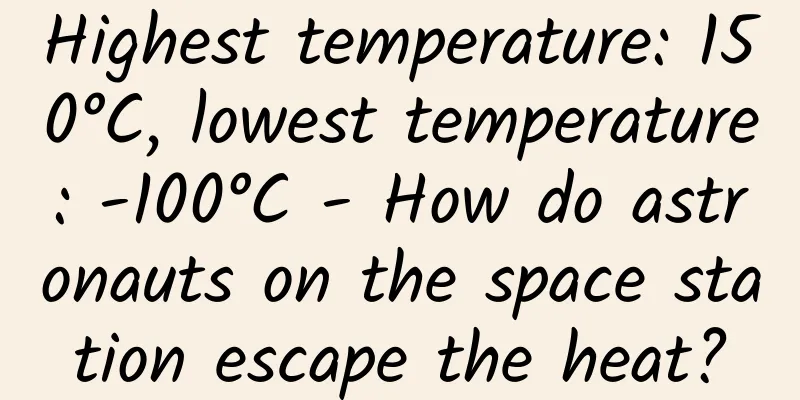Highest temperature: 150°C, lowest temperature: -100°C - How do astronauts on the space station escape the heat?

|
It's that time of year again when it's cold when you turn on the air conditioner, but hot when you don't! So the question is, have you ever thought that there are also such awkward temperatures in space? How do astronauts spend the summer? When you don't turn on the air conditioner, you feel hot all over! What are their tips for avoiding the heat? "Hot and cold", ice and fire First of all, we need to know: although the temperature in space is indeed very low, and even in many places the temperature is close to absolute zero (minus 273.15°C) , it is interesting that because space is a vacuum environment and there is no air as a medium, you will not intuitively feel the "cold" or "hot" environment when you are in it . The lack of a medium will result in objects in space (including humans themselves) having no heat convection and heat conduction. If they want to dissipate heat or absorb heat, they can only do so through thermal radiation , but thermal radiation has the lowest efficiency. Therefore, even though the temperature in space is very low, objects exposed to it will find it difficult to dissipate their own heat. In addition, although small objects like humans emit less heat through thermal radiation, this does not mean that there are no "big guys" in space: star As one of the main heat sources in space, stars emit a large amount of heat through thermal radiation every moment. Objects directly exposed to the thermal radiation of stars may experience a front temperature rise to over 100°C. Therefore, although space is very cold, due to the existence of stellar thermal radiation, spacecraft and astronauts often have to face extreme environments of ice and fire. Building a space home where “four seasons are like spring” Spacecraft far out in space also have a hard time, because artificial satellites, 300 km above the Earth's equator, are exposed to strong solar radiation 65% to 70% of the time. The Chinese space station , located 400 km above the Earth, has a surface temperature of up to 150°C under direct sunlight, while the temperature on the side facing away from the sun drops to below -100°C. Therefore, in order to maintain the working and living environment of scientific instruments and astronauts, scientists have specially developed a thermal control system to ensure the normal operation of the spacecraft and create a space home where "four seasons are like spring." Insulation through clothing When designing spacecraft, developers will deliberately design special "clothing" for them. This type of "clothing" is often designed with multiple layers and multiple materials . The purpose is to create multiple structures using highly reflective materials to form high thermal resistance, thereby preventing heat absorption and loss. Apply sunscreen In order to ensure constant temperature, the development team also coated the spacecraft with a layer of low-absorption and low-emission thermal control coating. Simply put, low absorption means reducing the warming effect caused by absorbing solar thermal radiation, and low emission means reducing the cooling factor caused by the dissipation of heat from the spacecraft. Nothing outside can come in and nothing inside can go out, so the thermal control coating can naturally and effectively maintain a constant temperature inside and outside the spacecraft. Turn on "Air Conditioning" In addition to the passive insulation mentioned above, active temperature control is also essential , and this is when the spacecraft's "air conditioning" needs to be turned on. For example, in the Chinese space station, the temperature control technology is realized through a liquid loop . Although it does not have a heavy outdoor unit, the principle of cooling by transferring heat is the same. By circulating the liquid repeatedly in every corner of the spacecraft, excess heat is collected and used to heat overcooled areas or dissipate the heat uniformly. This ensures that the temperature of each area can be maintained at an ideal state , and even the temperature of different rooms can be precisely controlled. |
<<: Special: How magical is the Chishui River?
>>: What is the "white frost" on fruits? Mold? Pesticide residue? Or...
Recommend
Universe-level production! Astronauts shoot "space station blockbuster" in orbit, how is it shot?
Produced by: Science Popularization China Author:...
Three common misunderstandings about hair care, must read before you have hair loss!
Mixed Knowledge Specially designed to cure confus...
What exercise hurts your knees the most? You definitely didn’t expect…
Once you sit down, how long do you sit? 1 hour? S...
Launch in the first half of the year! Chang'e 6 is here!
According to the National Space Administration, o...
When bees move to cities, can humans be good neighbors?
When it comes to bees, do you first think of beeh...
Building a forest on the sea? See how Fujian’s “forest system” has swept the nation →
World Forest Day Green water and green mountains ...
When spring comes and flowers bloom, go to the mountains, but don’t neglect ice and flood prevention!
Some time ago, when people were immersed in the b...
Can Xuefu Zhuyu Capsule remove freckles?
Xuefu Zhuyu Capsule is a medicine that is widely ...
The efficacy and contraindications of Panax notoginseng wine
Panax notoginseng is a common Chinese herbal medi...
Shocking news! The neck lump is actually a 40cm long parasite infection! Beware of these symptoms
Recently, the General Surgery Department II of Xi...
Unable to avoid information manipulation, is the human brain outdated?
Why are humans so susceptible to believing obviou...
The efficacy and function of the root of the petal flower
The root of the Pianpetal flower is a Chinese med...
Does snow lotus clear heat?
Snow lotus is a very precious Chinese herbal medi...









